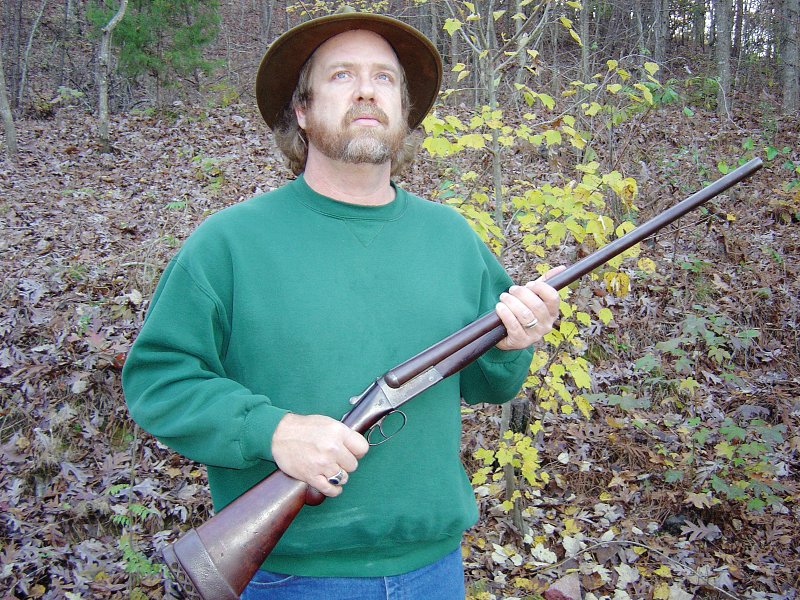My father and mother divorced when I was 5. I never saw my dad much after that. He loved to hunt, though, and he owned a sizable, collection of shotguns and rifles. When he died at the age of 57, my stepmother, Rose, gave the guns to me.
My favorite is a Remington Arms double-barrel 12 gauge. I frequently use it to hunt squirrels, rabbits and other game. I don’t know what model it is or how old it might be; there’s nothing on the shotgun to indicate these things. But it feels good in my hands, and I like the way it shoots.
I often wonder if my father liked it as much as I do. If appearances are any indication, he did. The stock is pitted and well-worn. The barrel needs rebluing. It’s obvious the shotgun didn’t just sit in a rack; it was used for hunting.
I’ve decided the gun needs a handle — not a handle with which you might carry something, but a special nickname to match its character, a name that by its being indicates this is a gun with special qualities, a gun that is cherished and used and familiar.
For some reason, the tradition of naming one’s favored firearm has fallen out of fashion. Of the scores of avid hunters I know, not one carries a gun he or she felt compelled to christen.
This was not always the case, however. If you look into the annals of history with an eye for such things, you’ll discover many well-known people who gave a handle to a much-loved gun.
Perhaps the best-known example is that of Davy Crockett and “Old Betsy.” Old Betsy was a .40-caliber rifle made by James Graham of Pennsylvania. She had a black-walnut stock, with brass hardware and silver inlays. This was a particularly beautiful firearm, and one the poor Sen. Crockett could never have afforded to own. As a member of the Tennessee State Assembly, Crockett championed veterans’ rights and made it easier for individuals to own land. So the constituents of Lawrence County took up a collection and presented him this rifle on May 5, 1822.
Much mythology surrounds Old
Betsy. While it is accurate to say that Crockett killed more than 100 black bears with her during six months of hunting in 1825 and 1826, it is not accurate to say that he used Old Betsy during the battle of the Alamo. Crockett left the flintlock with his son John Wesley upon departing for Texas. Legend has it that the gun was loaned to the Arkansas Historical Commission by John Wesley Crockett, great-grandson of Davy Crockett, in 1915 and kept there until it was returned to the family in 1951.
Daniel Boone was another legendary hero who carried a flintlock rifle. Crafted by his brother Squire, a skilled gunsmith, this .44-caliber Kentucky longrifle stretched more than 5 feet and weighed nearly 11 pounds. Boone dubbed the gun “Old Tick-Licker,” boasting he could use it to shoot a tick off an animal without hurting the beast. By modern standards, it was a massive firearm, bulky and unwieldy. But it was one of the finest guns of its day, surprisingly accurate and crafted with the durability that survival on the frontier demanded.
“Lucretia Borgia” was a .48-caliber trapdoor Springfield rifle owned by Buffalo Bill Cody. Cody may have gotten the idea for the name from Victor Hugo’s famed Lucretia Borgia, a play Cody may have seen in St. Louis. Borgia, the daughter of Pope Alexander VI, was described as a cold-blooded murderer in many dramas and books, and it is said Cody named his gun for her due to its deadliness.
Cody related details about the gun in a story told by Zane Grey in Last of the Great Scouts.
“I have killed over 40,000 buffalo, and most of them with that old gun …,” Cody said. “Our term of service on the Plains covered so many years, and so many different kinds of guns came into use that we tried out this one, then that one. The Winchester was well liked, as was the Spencer carbine, especially on horseback, but they could not shoot alongside of the .48-caliber needle-gun. That carried 70 grains of powder and 470 grains of lead. ‘Shoot to-day! — kill to-morrow!’ was what the Indians called it.
“That was my father’s rifle, and I love that gun.”
Recently, I pondered what I should name my favorite shotgun, the old Remington double-barrel 12-gauge that once belonged to my father.
I’m not sure if my mother-in-law, Helen, will appreciate the fact that I named the gun after her. It was a decision I arrived at only after considerable deliberation. A gun’s name should be a reflection of its character, I believe, and as I sat in the river bottoms one day, turning the old shotgun in my hands, I was most impressed by how beautiful she has remained despite her age. She reminded me of my wife’s mother, Helen.
Helen is a country lady, full of grace and goodness. She has not led an easy life, but the hardships she has endured during her life have only served to strengthen her character. She is deeply religious, generous to a fault and hospitable in the way of all true Southern ladies.
At the same time, I know one would not be wise to get crosswise with Helen. She doesn’t weigh 90 pounds soaking wet, but I have no doubt she could whip a grizzly with one hand behind her back. She is a lady to be respected.
My gun has these characters as well. She’s been around quite awhile, but she retains a unique beauty. One can never forget, however, that beauty in this case is beauty that must be respected.
Henceforth, the shotgun’s handle will be “Helen.” I just hope my mother-in-law appreciates the reasons my shotgun has become her namesake.
I wouldn’t want Helen to use Helen on me.
